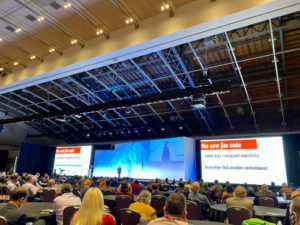Who do we listen to in higher education, and how we can work against daily–but critical–behind-the-scenes patterns that perpetuate racism and inequity in schools, communities, the workplace, and technological innovation?
From a young age, we’re fed the idea that a technology-driven utopian society will make our lives more efficient, more fair, and will save us, said Ruha Benjamin, professor of African American Studies at Princeton University and author of People’s Science: Bodies and Rights on the Stem Cell Frontier, during the opening keynote of EDUCAUSE’s annual conference. But coded inequities perpetuate harmful patterns in our society.
Benjamin has studied the social dimensions of science, technology, and medicine for over fifteen years and speaks widely on issues of innovation, equity, health, and justice in the U.S. and globally.
Technology shapes us, but behind that technology are humans with their own biases, interests, assumptions, and ideas. These become encoded in our sociotechnical structures.
“As it stands today, there’s a very small sliver of humanity whose imagination is getting encoded into our digital world,” Benjamin said. “Part of the work I see us in higher education responsible for is to broaden whose imagination, values, and needs become encoded in those structures.”
Efforts must be made to democratize not just access to technology, but the design of technology. Higher education, Benjamin added, is very much ground zero when it comes to this responsibility.
Examples of limited perspectives in technology are plentiful. An image search for professional hairstyles pulls up images of white women, while an image search for unprofessional hairstyles displays Black women with natural hair. Data from an AI hiring tool that vets job applicants shows that applicants with names traditionally associated with a white person received 50 percent more callbacks.
These perspectives aren’t limited to technology. Take, for example, a public bench. Benches across the world have various features designed to prevent certain populations from using them–for example, a bench with arms at regular intervals to discourage lying down, small benches wide enough for only one person to sit upright, or benches with spikes on the seat that can only be removed by paying to do so. These measures are all the result of a human idea–and they all target, or aim to exclude, different populations or types of people.
“With innovation comes inequity if we carry on business as usual,” Benjamin said. “If we don’t rigorously and actively try to address inequity in our pursuit of innvoation, those two things go hand in hand.”
So, what happens when we notice the “spikes” in the systems around us? How do we become more discerning and figure out how we might be unwittingly perpetuating forms of harm and exclusion?
One of the first steps is to create a shared vocabulary and a shared understanding of the problem before us. We have to understand that “racism distorts how we see and how we’re seen,” Benjamin said. It distorts our ability to read things at the institutional level and our interpersonal dynamics. It even distorts our internal reality, how we read ourselves, how we understand ourselves as supposedly inferior or superior. “Racism is distorting our ability to see the world clearly,” she added.
What do we do when we’re creating new technologies and new systems that perpetuate what Benjamin calls “the new jim code”–innovation that has enabled new forms of social containment and social inequity?
Higher education is the starting point, Benjamin noted. Those in higher education must work to understand their social reality and strive to make it more equitable and just. “If we only work to make it more equitable and just without understanding the problem well enough, we’re at risk of repeating the problem,” she said.
Technological innovations may well be full of harmful patterns, but those patterns can be changed.
“We don’t have to carry on the patterns of the past. We have the power, the responsibility even, to look at the fine print and begin to change those patterns,” Benjamin said. This starts with focusing on everyday practice and pedagogy, redirecting attention to things that often go ignored, and questioning aspects of our work we’ve been taught not to question.
Advancing Racial Literacy in Tech, a handbook addressing racial disparities in technology, notes that working to erase coded inequities requires intellectual understanding, emotional intelligence, and commitment to working with communities impacted by racism.
Now what? Identify forms of coded inequity, or “spikes,” in your own workplace, Benjamin urged. Imagine new patterns of thought and action. Work with groups most impacted by harmful systems–and listen to them.
- First-generation students are more likely to seriously consider leaving college - April 17, 2024
- How higher ed can meet workforce needs - April 15, 2024
- Higher ed leaders believe continuing education units are undervalued - April 10, 2024

